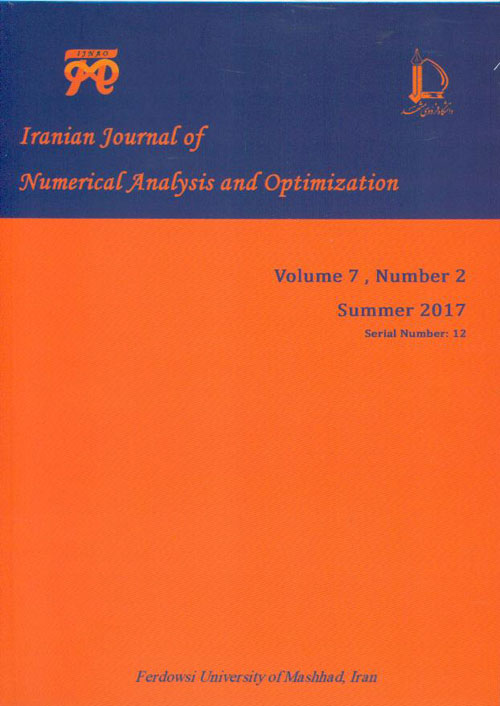فهرست مطالب

Iranian Journal of Numerical Analysis and Optimization
Volume:7 Issue: 2, Summer and Autumn 2017
- تاریخ انتشار: 1396/08/02
- تعداد عناوین: 7
-
-
Pages 1-14Image magnification is one of the current issues of image processing in which keeping the quality and structure of images is the main concern. In im- age magnification, it is necessary to insert information in extra pixels. Adding information to an image should be compatible with the image structure with- out making artificial blocks. In this research, extra pixels are estimated using the surface of least squares, and all the pixels are reviewed according to the suggested edge-improving algorithm. The suggested ethod keeps the edges and minimizes the magnified image opacity and the artificial blocks. Numer- ical results are presented by using PSNR and SSIM fidelity measures and compared to some other methods. The average PSNR of the original image and image zooming is 32.79 which it shows that image zooming is very similar to the original image. Experimental results show that the proposed method has a better performance than others and provides good image quality.Keywords: Image Magnication, Least Squares Surface, Interpolation
-
Pages 15-38The main purpose of this article is to describe a numerical scheme for solving three-dimensional linear Fredholm integral equations of the second kind on the cubic domains. The method is based on interpolation by radial basis functions (RBFs) based on Gauss-Legendre nodes and weights. Error analysis is presented for this method. Finally, several examples are given and numerical examples are presented to demonstrate the validity and applicability of the method.Keywords: Three-dimensional integral equation, Radial basis functions, Collocation method, Cubic domains
-
Pages 39-56In this paper, we address a new problem in the context of project payment scheduling when project activities are allowed to be crashed with the purpose of maximizing the contractors net present value (NPV). We assume that the contractor is paid at some pre-specified points of time according to the volume of work performed. Upon completion of activities, the cost of their execution is paid. Two different approaches are used to determine the volume of work performed at so called review points. In the first approach, only completed activities are considered. In the second approach, any portions of the activities that are executed are considered. To increase the volume of work performed at the review points, the contractor may decide to crash some activities and as such possibly increases his NPV. As activity crashing costs the contractor money, a compromise needs to be made. Two mathematical models are developed to study each approach and hence help the contractor to make the best decision. These models offer a means of investigating whether it is advisable to crash some activities and are therefore of practical importance. It is shown that the contractor may increase his NPV, even when he pays for the activity crashing costs. The performance of the mathematical models is illustrated using a numerical example.Keywords: Payment scheduling, Progress payment, Project crashing, Con- tractor's net present value
-
Pages 57-64In this paperý, ýwe give an algorithm to compute the minimum 1-norm solution to the absolute value equation (AVE)ý. ýThe augmented Lagrangian method is investigated for solving this problemsý . ýThis approach leads to an unconstrained minimization problem with once differentiable convex objective functioný. ýWe propose a quasi-Newton method for solving unconstrained optimization problemý. ýComputational results show that convergence to high accuracy often occurs in just a few iterationsý.Keywords: Absolute value equation, Minimum norm solution, Generalized Newton method, Augmented Lagrangian method
-
Pages 65-86In the last sixty yearsý, ýthe Dynamic Relaxation methods have evolved significantlyý. ýThese explicit and iterative procedures are frequently used to solve the linear or nonlinear response of governing equations resulted from structural analysesý. ýIn the first part of this studyý, ýthe common DR formulations are reviewedý. ýMathematical bases and also physical concepts of these solvers are explained brieflyý. ýAll the DR parametersý, ýi.eý. ýfictitious massý, ýfictitious dampingý, ýfictitious time step and initial guess are describedý, ýas wellý. ýFurthermoreý, ýsolutions of structural problems along with kinetic and viscous damping formulations are discussedý. ýAnalyses of the existing studies and suggestions for future research trends are presentedý. ýIn the second partý, ýthe applications of Dynamic Relaxation method in engineering practices are reviewed.Keywords: dynamic relaxation methodý, ýformulationý, ýsolverý, ýreviewý, ýiterative techniqueý, ýstate of the art
-
Pages 87-114The most significant advances over the sixty years relative to the Dynamic Relaxation applications in structural engineering are summarized. Emphasized are given towards plates, form finding, cable structures, dynamic analysis, and other applications. The role of DR solver in the linear and non-linear analyses is discussed. This investigation is undertaken to explain the application of the solution technique to the static, dynamic and stability problems. The influence of the methods on the use of isotropic and composite materials, such as orthotropic and laminated ones, is briefly covered. Critical analyses and suggestions regarding future research and applications will be presented.Keywords: Dynamic Relaxation method, Application, Survey, Solver, Review, Iterative technique, State of the Art
-
Pages 115-135In this paper, we apply a local discontinuous Galerkin (LDG) method to solve some fractional inverse problems. In fact, we determine a timedependent source term in an inverse problem of the time-fractional diffusion equation. The method is based on a finite difference scheme in time and a LDG method in space. A numerical stability theorem as well as an error estimate is provided. Finally, some numerical examples are tested to confirm theoretical results and to illustrate effectiveness of the method. It must be pointed out that proposed method generates stable and accurate numerical approximations without using any regularization methods which are necessary for other numerical methods for solving such ill-posed inverse problems.Keywords: Local discontinuous Galerkin method, Inverse source problem, Time-fractional diffusion equation

